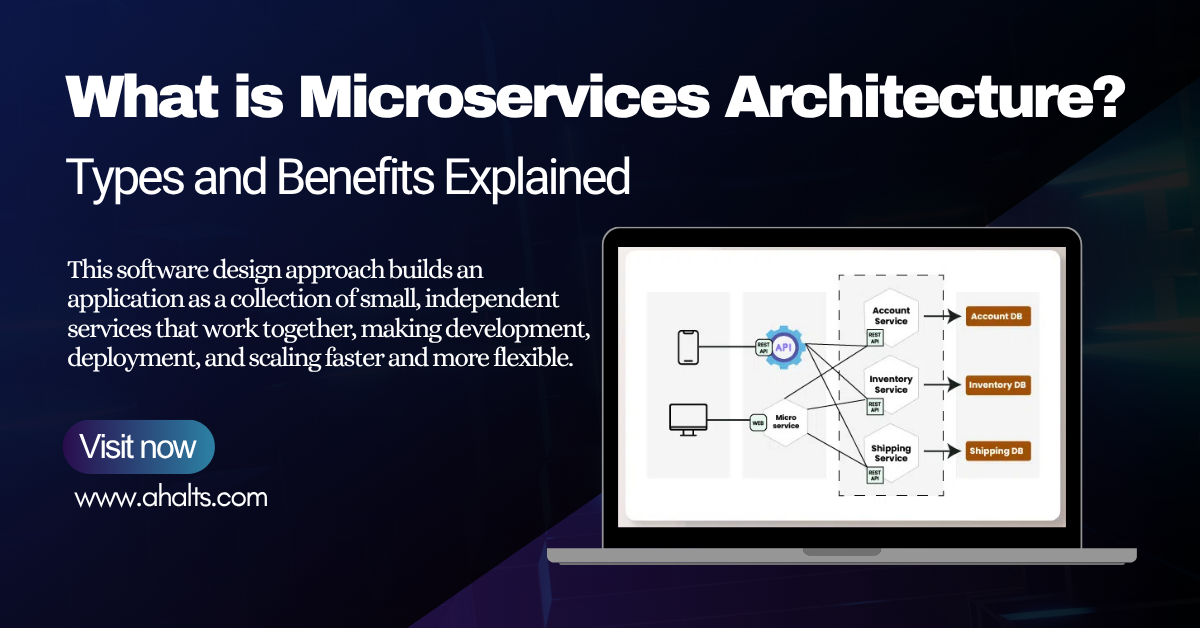Wonder how apps such as Netflix or Amazon can work so efficiently, even with millions of users? The key to their efficiency is called microservices architecture. It’s no longer exclusive to tech giants. Companies of any size are now leveraging it to create faster, smarter, and more resilient software.
At Ahalts, we think that learning about this idea doesn’t have to be difficult. In this article, we’ll explain what microservices architecture is, examine the various types of microservices architecture, and discuss the best benefits of microservices architecture—all in plain language you can really comprehend.
Microservices Architecture
Let’s begin with the grand question: What is microservices architecture?
Suppose you are constructing a house. Rather than constructing one enormous room, you construct individual rooms—kitchen, bedroom, bathroom—each performing a specific function. Microservices are similar. Rather than constructing an enormous application, developers divide it into smaller units known as “services.” Each service performs one particular function, such as processing payments, storing users, or sending emails.
These services communicate with one another using simple APIs. And the good news? They can be developed, revised, and scaled separately.
That’s what distinguishes microservices architecture from the traditional monolithic approach to developing apps. Rather than having to revise the entire system for a tiny change, you simply revise the piece that needs to be repaired. Easy enough?
Types of Microservices Architecture
Since you now know what is microservices architecture, let us see the types of microservices architecture you may encounter:
Decomposed by Business Function
Each service revolves around a single business requirement, such as billing, user profiles, or notifications. It is the most popular type. It makes your app simple to scale and maintain.
Decomposed by Subdomain
This architecture is common in big businesses. It divides services by business domain parts. For instance, “Orders” and “Inventory” could be different services in an e-commerce application.
API-Driven Microservices
Here, all the services are linked with APIs. This simplifies it for various teams to work independently. It also makes your system talk to third-party applications.
Event-Driven Microservices
Services respond to events (such as a user buying something). It’s quick, efficient, and perfect for real-time use cases.
Each of these styles has its application. The correct one is based on your app’s size, your team’s experience level, and how quickly you need to scale.
Advantages of Microservices Architecture
So why go through the trouble of changing to microservices? Here are the most significant advantages of microservices architecture:
- Faster Development
Because every service is developed independently, teams can work simultaneously. This accelerates the whole development process.
- Easy to Scale
Want extra power for your checkout process on sale day? Simply scale that microservice, without touching the rest of your system.
- Quick Updates
You can release new features or patch bugs in one service without having to wait to test the entire app.
- Better Reliability
If one service fails, the others remain operational. Your entire app isn’t taken offline.
- Tech Flexibility
Every team can pick the optimal tools or programming languages for their service. You’re not locked into using one configuration across the board.
These advantages make microservices an ideal choice for contemporary apps. That’s why increasing numbers of businesses are resorting to platforms like the Ahalts AI Microservice Platform to develop intelligent, scalable systems.
Conclusion
In short, microservices architecture is all about creating intelligent and adaptable apps. Rather than doing everything in one large block, you break things up and handle them better. Understanding the various types of microservices architecture assists you in selecting the appropriate design for your project. And the benefits of microservices architecture? Quicker updates, reduced downtime, and greater liberty for your team.
It’s not a buzzword—it’s a smarter way of building.
Ready to build smarter? Learn how the Ahalts AI Microservice Platform enables you to design, deploy, and manage microservices with ease.
Frequently Asked Questions
Microservices architecture is for large companies only, right?
No! Startups and small businesses can too. It enables you to scale and evolve rapidly.
What’s the primary distinction between monolithic and microservices architecture?
Monolithic applications are developed as a single large unit. Microservices divide the application into smaller independent units.
Are microservices difficult to manage?
They are if they’re manual. But with services like Ahalts, microservices are easy and effective to manage.
Can I convert my existing app into microservices?
Yes, most companies transition from monolithic to microservices gradually. It’s a process that is possible and step by step.
What do I need to execute microservices?
You will require deployment, communication, and monitoring tools. The Ahalts platform has all that you require under one roof.




